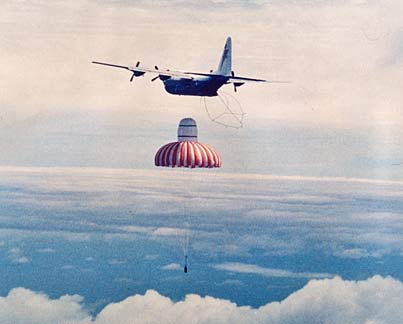
|
Spy satellite recovery
was plum Air Force job
The old Hickam unit marked its
first midair recovery 45 years ago
For nearly eight years, Larry Kimball believed he had one of the most ideal jobs in the Air Force.
He was part of what was then a highly classified military operation: a pararescue jumper whose job was to help recover spy satellites in the Pacific.
"The recovery missions were a high priority in the Pentagon," said Kimball, 53. "Since it had such a high priority, it was extremely well funded."
Kimball, then an Air Force sergeant, was a member of the 6594th Test Group at Hickam Air Force Base, which made its first midair recovery of a spy capsule 45 years ago today.
Over its 27 years of existence, the 6594th completed 40,000 aerial operations and retrieved nearly 200 film capsules ranging in cost from $7 million to $250 million each, said Al Blankenship, who was assigned to the group from December 1969 until it closed in September 1986.
Besides its military mission, the Hickam unit also worked with the Coast Guard on rescue missions. Blankenship estimates that more than 60 people were rescued at sea.
The unit's slogan was "Catch a Falling Star," since it used modified cargo planes to snag spy capsules as they descended into the Pacific Ocean by parachute.
Kimball, who later was commissioned through the University of Hawaii Air Force ROTC program, said pararescue jumpers like himself -- nicknamed "PJs" -- were used "in case something went wrong."
"If the capsule overshot its mark and went downrange, as we used to say," Kimball added, "and landed in a different area before the C-130 Hercules cargo plan could snag it, that's when I would go into the water."
Kimball said he would have to parachute from a C-130 at about 1,200 feet, swim to the capsule and place a special flotation collar around it, similar to those used to keep the manned space capsules afloat.
The other method was for him to jump with a parachute anywhere from 10 to 20 feet from a hovering HH-53 Super Jolly Green Giant helicopter.
"It took a lot of timing by the pilot to watch the waves and signal a jump," Kimball said, "so the jumper would land on a crest of wave rather than in a trough. If he mistimed it, that could mean a longer fall, like 20 feet."
"The 6594th Test Group was the only organization to recover de-orbiting satellite film capsules, and the Hawaiian Islands was the only location for U.S. satellite film capsule recovery," Blankenship said.
Its first successful midair recovery was accomplished on Aug. 19, 1960, and involved the Discovery 14 capsule. It used a modified JC-119 Flying Boxcar cargo plane. Both the capsule and the aircraft are on display at the Air Force Museum at Wright-Patterson Air Force Base in Ohio.
Blankenship estimates that between 1958 to 1972, there were about 145 attempted satellite launches involving 200-pound capsules.
"I think we were able to recover about 120 of them," he said.
Starting in 1972, the capsules were much heavier -- "about 1,110 pounds," Blankenship said. "I think we recovered about 95 percent of them." Advances in digital video technology ended the 6594th's mission on Sept. 30, 1986.
E-mail to City Desk
[News] [Business] [Features] [Sports] [Editorial] [Do It Electric!]
[Classified Ads] [Search] [Subscribe] [Info] [Letter to Editor]
[Feedback]
